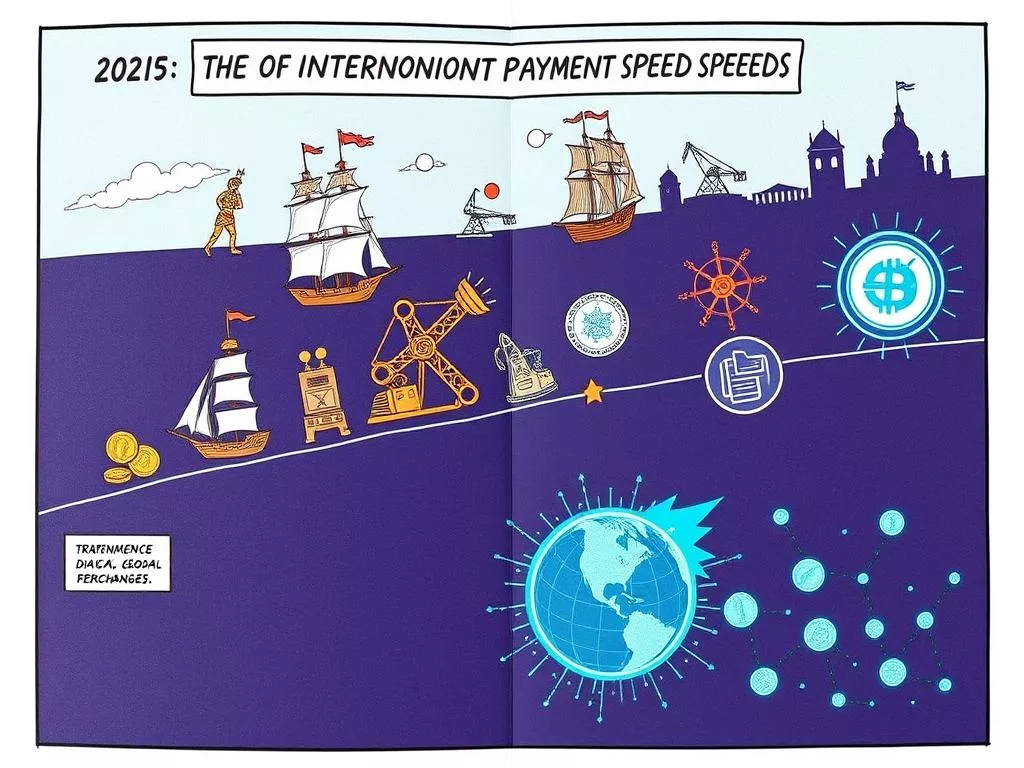In today’s fast-paced world, making payments across borders quickly is key. This guide looks at how fast global payments have gotten over time. We’ll see how old systems like SWIFT have changed with new tech like blockchain and fintech.
We want to show how these changes have made sending money abroad better. And how they will keep improving as we move forward.
Old days of payments were slow, using things like telegraphic transfers and SWIFT. SWIFT helps over 10,000 banks in 212 countries. But, making payments fast and cheap is a big challenge.
The Financial Stability Board (FSB) and others are working hard to fix this. For example, in November 2022, SWIFT sent out 44.8 million messages a day. This was a 7.1% increase from the year before.
This guide will show you how making payments better is happening. Things like using ISO 20022 standards and working longer hours help. The G20 is also working on big payment system problems.
Knowing about these efforts is important. It helps us understand today’s payment systems. And it lets us see what the future might hold.
The Evolution of International Payment Speeds
The journey of international payment systems has seen big changes. These changes came from new technology and rules. At first, SWIFT payments were the main way to send money across borders. They were slow, often taking longer on weekends.
But then, technology got better and so did payment systems. This made sending money faster and easier.
International agreements and groups like the Financial Stability Board (FSB) played a big role. They helped make SWIFT payments faster with the G20 Roadmap and ISO 20022. ACH transfer speeds also became faster, making business-to-business payments quicker and more reliable.
Cryptocurrencies have also changed the game. By October 2023, their market value was around $1.3 trillion. Stablecoins, with a value of about $125 billion, show they can be safe and reliable for sending money.
The evolution of payment systems in Europe, Japan, and the U.S shows how different countries affect these systems. The dollar’s role as the world’s reserve currency helps the U.S. in global finance, including through payment systems.
- Central banks hold only 5% of their reserves in pounds, showing a move to digital currencies.
- Over 86 central banks are working on Central Bank Digital Currency (CBDC) projects, with China, Brazil, and India leading the way.
- Businesses using B2B real-time payment systems see better efficiency, lower costs, and faster growth.

The future of international payments looks bright. With faster ACH transfer speeds and the impact of cryptocurrencies, payments are getting quicker and safer.
Current State of International Payment Systems
The world of international payments is changing fast. New tech and the need for quick, clear transactions are driving this change. As global B2B payments are set to hit $124 trillion by 2028, the need for fast and connected payment systems is growing.
Recently, ACH transfers have become key for cross-border payments. They are cheap and efficient. Also, payment APIs are making it easier to move money across different systems and currencies.
But, there are challenges. Payments can take days, which hurts businesses that need quick transactions. Each country has its own rules, like AML and KYC, making things more complicated.

Hidden fees and complex rules also make things tough. Businesses struggle to track payments due to lack of real-time info. This leads to mistakes and errors.
Security is another big issue. Payments involve many parties, making them vulnerable to fraud. Keeping transactions safe requires strong financial tools and protocols.
Yet, new platforms like Wise and Currencies Direct are showing the way forward. They offer simpler and faster ways to make payments. The growth in global real-time transactions, up 42% in 2023, shows more people want quick payment options.
To succeed, businesses need to use new tech and stay up-to-date with rules. Checking out resources like the guide to international payments can help.
Here’s a table with key stats and trends in international payments:
| Metrics | Statistics |
|---|---|
| Global B2B Payments by 2028 | $124 trillion |
| Expected Increase in Cross-Border Payments (2017-2027) | $100 trillion |
| Percentage of RTP Transactions by 2028 | 25% |
| Time-Sensitive Industries Affected by Delays | Manufacturing, Perishable Goods |
| Typical Fee for Currency Conversion Worldwide | 6.5% |
| Daily FX Market Turnover | $7.5 trillion |
| Countries with RTP Systems (2023) | 72 |
Guide to International Payment Speeds: Past, Present, Future
The journey of international payment speeds has been complex. It has been shaped by history, current tech, and future dreams. In the past, international transactions were slow and hard to manage. The introduction of Automated Clearing House (ACH) transactions was a big step forward.
ACH made payments faster, reaching recipients in a few business days. But, international ACH transfers were tricky. They needed detailed info like bank account and routing numbers.
Today, international payments have made big strides. New global payment protocols and tech have improved things a lot. ACH payments are now quicker and more efficient than old wire transfers.
But, we need faster, cheaper, and clearer payments. New tech like blockchain and cryptocurrencies look promising. They could make transactions even quicker and cheaper.
The future of banking and finance is all about modernizing payments. Financial groups and central banks are working on new solutions. They’re looking at Central Bank Digital Currencies (CBDCs) to change retail payments.
CBDCs could make payments stable and encourage new ideas. It’s also important to focus on digital and other innovations in wholesale payments. As we move forward, knowing the differences between ACH types will be key. Embracing new tech can make international payments faster, safer, and clearer.

